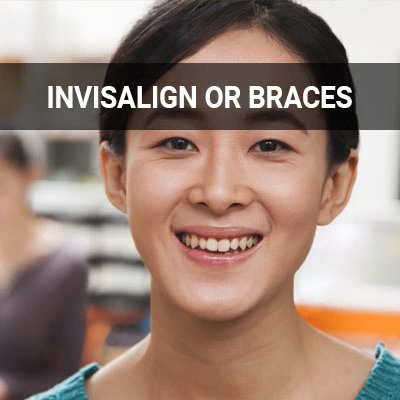Does Invisalign Really Work Federal Way, WA
Invisalign® is a popular alternative to traditional metal braces. Many patients favor them for their discreet, almost invisible appearance. For many patients, Invisalign can deliver results almost as quickly and as efficiently as traditional metal braces.
Invisalign is available at Smile Center Dental Care in Federal Way and the surrounding area. We can help you achieve the smile of your dreams without a mouth full of metal. Call us today at (253) 336-0023 to schedule an appointment and learn more.
The Research on Invisalign
Invisalign is the world's most popular and advanced clear aligner system. With over twenty years of innovation on its side, it has delivered smiles to over nine million people and over 2.3 million teens. Each patient receives a set of custom-made aligners. The system includes proprietary virtual modeling software, rapid manufacturing processes, and mass customization, and the aligners consist of a patented material.
To achieve the best results, patients must wear their aligners for 20 to 22 hours per day, removing them only when necessary. Such instances include eating or drinking anything other than cool water. Patients must also keep regular visits to both the dentist and the orthodontist. The dentist can ensure the mouth is in optimal health, reducing the risk of Invisalign irritating any conditions. The orthodontist can ensure the treatment's overall success while also switching out the patient's aligners.
“With over twenty years of innovation on its side, it has delivered smiles to over nine million people and over 2.3 million teens.”
Commonality by Age Group
Invisalign is made for patients of all ages. A 2015 article found that Invisalign treatment is common in patients between 13.6 and 31.9 years old. We find that teens and adults are the most common patients seeking Invisalign treatment due to its comfort, discreetness, and shortened treatment time.
Invisalign created the first clear aligner treatment, called Invisalign First, for children with primary teeth and growing permanent teeth. Children start growing permanent teeth between 6 and 7 years old, and orthodontic treatment can help guide the teeth into proper development. Invisalign treatment is available for children, teens, and adults with conditions viable for treatment.
“We find that teens and adults are the most common patients seeking Invisalign treatment due to its comfort, discreetness, and shortened treatment time.”
What to Know About Invisalign
As mentioned above, many teenagers and adults are good candidates for Invisalign. However, as metal braces tend to deliver more precise results, Invisalign is best for patients with mild or moderately crowded teeth. Patients with minor teeth spacing issues may also benefit from clear aligners. Anyone who wants to start Invisalign treatment must also first address any gum disease or other dental disease, making dental appointments essential.
Furthermore, patients with more complicated issues with crowding or spacing (such as severe underbites, overbites, or crossbites) may require more intensive treatment. Invisalign is also typically unsuitable for children, as their mouths are usually still developing. Their teeth are still growing and changing, making them too unpredictable for clear aligners.
“…Invisalign is best for patients with mild or moderately crowded teeth.”
Check out what others are saying about our dental services on Google: Does Invisalign Really Work in Federal Way, WA
Invisalign vs. Traditional Braces
There are a few differences between Invisalign and traditional braces. The most obvious is aesthetics. When used appropriately, Invisalign is almost entirely inconspicuous — making it perfect for more self-conscious patients. Aligners are also removable, making them more convenient for eating and upkeeping oral hygiene.
Metal braces consist of two main components: brackets and wires. These place consistent, gentle pressure on the teeth to shift them gradually. Brackets are attached to the teeth, meaning they cannot be removed. As a result, many patients find them less comfortable than Invisalign, and it is typically more challenging to maintain oral hygiene. Patients will also need to avoid hard, crunchy, chewy, or sticky foods to prevent breaking the brackets or having them get stuck between the braces.
“When used appropriately, Invisalign is almost entirely inconspicuous — making it perfect for more self-conscious patients.”
Questions Answered on This Page
Q. Is Invisalign backed by research?
Q. Am I a good candidate for Invisalign?
Q. What is the difference between Invisalign and traditional braces?
Q. Is there anything I need to avoid with Invisalign?
Q. Is there commonality by age group?
People Also Ask
Q. How long does Invisalign take?
Q. How do clear aligners save time straightening?
Q. What are the pros and cons of Invisalign?
Q. How can someone find the right Invisalign Dentist?
Q. What are the aesthetic differences between braces and Invisalign?
Q. How effective is Invisalign in treating overbites and underbites?
Invisalign & Lifestyle Changes
One of the many advantages of Invisalign is that it requires minimal lifestyle changes. Patients will have to switch out their aligners every one or two weeks, and they will need to come into the office to pick up their new set of aligners every six to eight weeks. In most cases, Invisalign patients require fewer orthodontist visits than braces patients.
Still, there are some things patients should know to complete Invisalign treatment safely. They must care for them properly to avoid staining or other undesirable results. This involves rinsing the aligners nightly, brushing them gently with a soft-bristled toothbrush to keep them clean. If possible, patients should rinse them whenever they take them out. As mentioned earlier, patients should only remove aligners when necessary — such as when eating, brushing, or drinking anything other than cool water. Patients who play high-contact sports should ask Smile Center Dental Care if it is safe to keep the aligners in the mouth while playing.
“One of the many advantages of Invisalign is that it requires minimal lifestyle changes.”
Frequently Asked Questions
Q. Who is not a candidate for Invisalign treatment?
A. Invisalign is not for patients with severe dental or orthodontic conditions. It may not be suitable for patients who have difficulty with self-reliance or know they may not adhere to necessary protocol. Lastly, patients with several prior dental treatments or surgeries may not be good candidates due to weakened bone.
Q. How is candidacy determined?
A. During the initial consultation, patients are examined using a 3D scanner that takes hundreds of photos per second and creates an accurate digital image. We also conduct a physical oral exam and check for any signs of wear-and-tear or gingival decay. The Invisalign system interprets the findings and helps us determine whether the patient is a good candidate for treatment.
Q. What happens during Invisalign treatment?
A. Once a patient qualifies for Invisalign, we curate a treatment plan using the smile scan conducted during the consultation. The 3D renderings are sent to a lab that creates the custom trays for the first few weeks. The patient will have follow-up appointments every 4 to 6 weeks to check progress and are given their next sets of aligners.
Q. Will I have to wear a retainer after I complete treatment?
A. As with all orthodontic treatments, it is highly advised that patients wear a retainer to avoid relapse or shifting. Teeth tend to naturally shift back to their original placement without a device applying a specific amount of force. However, wearing a retainer even once a week for at least a year can make a big difference in long-term results.
Q. How long is the average treatment duration with Invisalign?
A. The length of treatment varies with each case. Patients may take as little as six months or as long as three years depending on the severity of their condition. It also depends largely on patient adherence to their individualized instructions and proper care and maintenance.
Invisalign® Terminology
Learn More Today
Invisalign can help you get the smile of your dreams without a mouth full of metal. We at Smile Center Dental Care can help. Call us today at (253) 336-0023 to schedule an appointment and learn more.
Helpful Related Links
- American Dental Association (ADA). Glossary of Dental Clinical Terms. 2024
- American Academy of Cosmetic Dentistry® (AACD). Home Page. 2024
- Invisalign®. How Invisalign Works. 2024
- Invisalign®. Take the Smile Assessment. 2024
- WebMD. WebMD’s Oral Care Guide. 2024
About our business and website security
- Smile Center Dental Care was established in 2005.
- We accept the following payment methods: American Express, Cash, Check, Discover, MasterCard, and Visa
- We serve patients from the following counties: King County and Pierce County
- We serve patients from the following cities: Federal Way, Auburn, Kent, Des Moines, Tacoma, Fife, Milton, Edgewood, SeaTac, and Algona
- National Provider Identifier Database (1770035289). View NPI Registry Information
- Norton Safe Web. View Details
- Trend Micro Site Safety Center. View Details
Back to top of Does Invisalign Really Work











